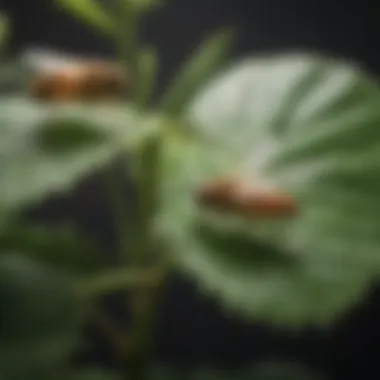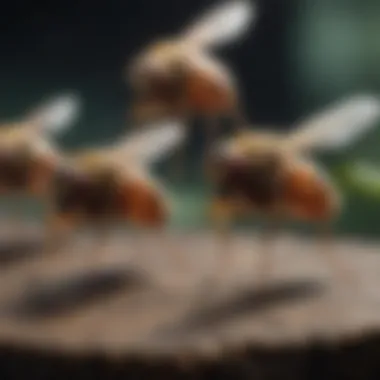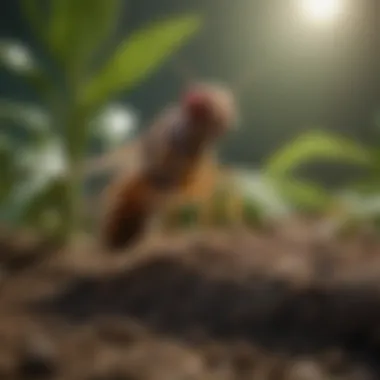Effective Strategies to Eliminate Fruit Flies on Houseplants


Intro
Fruit flies are not just annoying; they can indicate larger problems in your houseplants. These small insects are known for their rapid reproduction and can become a serious issue if left unchecked. Their presence often suggests overripe fruit, decaying plant matter, or excess moisture. Understanding their life cycle is vital for effective control. This article will explore various methods to eliminate these pests, focusing on practical advice for both prevention and remediation.
Fascinating Facts About the Animal
Unique Characteristics
Fruit flies, scientifically designated as Drosophila melanogaster, are remarkably small, measuring about 1/8 inch in length. They tend to have a yellowish-brown body with distinctive red eyes. Their lifecycle is impressively short; under optimal conditions, they can develop from egg to adult in just about a week. Their ability to reproduce quickly allows populations to explode if not managed properly.
Extraordinary Abilities
These insects possess unique olfactory sensors that enable them to detect ripe and rotting fruits with keen accuracy. This ability is vital to their survival, allowing them to locate food sources for feeding and breeding. Additionally, fruit flies are known to exhibit a variety of behaviors that indicate their adaptability. For example, they can fly at speeds up to 5 miles per hour and can respond quickly to environmental changes, making them an interesting subject for scientific research.
Behavior and Habitat
Natural Habitats
Fruit flies thrive in environments rich in fermenting and decaying organic matter, such as kitchens with fruit bowls left unattended or near overwatered houseplants. They prefer warm temperatures and high humidity, which are often found indoors, especially during the summer months. Keeping houseplants in such conditions can inadvertently encourage these pests to make themselves at home.
Social Structures
Though fruit flies do not have social structures in the traditional sense, they do exhibit behaviors that may suggest a form of communal living. For instance, they tend to congregate around food sources and can generate large swarms in areas rich in nutrients. This behavior can amplify infestations, as they not only breed quickly but also attract more fruit flies to the same area.
Recent Scientific Discoveries
Latest Research Findings
Recent studies have examined the genetic makeup of fruit flies and how it influences their behavior and adaptability. Research focuses on understanding the mechanisms that allow them to thrive in diverse environments. This information is crucial for developing targeted control methods, as knowing their biological make-up can aid in creating effective bait and traps.
Breakthroughs in Animal Biology
Using fruit flies as a model organism in biological studies has significant implications for genetics and ecology. Scientists have made substantial advances in identifying genetic markers related to their breeding and resistance to various control methods. This research is paramount in the surveillance of more resilient pest populations, potentially aiding in a broader pest management strategy.
End
The intricate biology and behaviors of fruit flies reveal just how pervasive they can be as pests in houseplants. Understanding their characteristics and habitats can assist in developing strategies to eliminate them effectively. By integrating knowledge of their lifecycle and habits, houseplant enthusiasts can implement both preventive and remedial strategies to maintain the health of their valuable plants.
Understanding Fruit Flies
Fruit flies pose a significant challenge for those who cherish houseplants. Their presence is not only annoying, but they can also indicate underlying problems in plant care. Understanding fruit flies is vital for effective pest management. Knowledge about their biology and life cycle allows us to address the core issues that lead to infestations. By grasping this concept, plant owners can adopt proactive strategies to prevent and control their impact on plant health.
Biology of Fruit Flies
Fruit flies belong to the Drosophila genus, with Drosophila melanogaster being the most recognized species. These insects are small, ranging from 1/8 to 1/4 of an inch long. Their bodies are often tan or yellow-brown, with distinctive red eyes. Fruit flies are attracted to fermenting and overripe fruits, laying their eggs on these decaying organic materials. The adult flies feed primarily on the sugars in these substances, feeding both before and after the eggs are laid. Understanding their feeding habits can be beneficial when trying to create environments that discourage their presence.
Life Cycle of Fruit Flies
The life cycle of fruit flies consists of four stages: egg, larva, pupa, and adult. The process begins when a female lays approximately 500 eggs on the surface of fruit or moist organic matter. These eggs hatch within 24 to 30 hours, leading to a larval stage where they feed on the surrounding materials. After about a week of feeding, the larvae then pupate. This pupal stage lasts approximately 4 to 6 days. Finally, they emerge as adults, capable of reproduction. This rapid development means a small infestation can escalate quickly, necessitating swift action to maintain plant health.
Understanding the life cycle is crucial. It helps in selecting appropriate control methods that target fruit flies at their most vulnerable stages.
Both biology and life cycle analysis are essential components in managing fruit flies effectively. This knowledge not only emphasizes the necessity for preventative actions but also guides decision-making if infestations do occur.
Identifying Fruit Flies in Houseplants
Identifying fruit flies in houseplants is a critical step in managing their presence. Recognizing the early signs of an infestation can significantly influence the outcome. Quick identification leads to more effective control, preventing the situation from escalating into a larger problem. The sooner one understands that fruit flies are present, the easier it becomes to apply the necessary measures to eliminate them.


Signs of Infestation
Understanding the signs of infestation is vital. Fruit flies typically thrive in moist environments, especially where decaying organic material exists. Here are several indicators to look for:
- Sightings of Adult Flies: Adult fruit flies are around 1/8 inch long and have red eyes. They are commonly seen hovering around houseplants, especially near the soil.
- Larvae Presence: If you notice small, white worms in the soil or on the surface, those are likely fruit fly larvae. They can be harder to spot but often appear near organic matter.
- Soil and Plant Condition: Healthy houseplants show no signs of wilting or decay. If leaves are yellowing or showing other signs of stress, it could indicate a deeper issue like a fruit fly infestation or another underlying problem.
- Presence of Fungus Gnats: While they are not the same species, fungus gnats often accompany fruit flies. If you see these small, dark insects, any infestation might be more serious than originally thought.
Being vigilant and regularly inspecting your plants will help identify these signs early, allowing you to take corrective action before the situation worsens.
Common Types of Fruit Flies
Understanding the types of fruit flies often found in houseplants can further aid in identification. The most common kinds include:
- Drosophila melanogaster: This is the most well-known fruit fly. It is typically light brown and often associated with decaying fruits. If found around houseplants, it's likely feeding on organic debris in the soil.
- Drosophila simulans: This species is similar in appearance to Drosophila melanogaster but often prefers slightly different types of organic matter. They can appear in indoor plants if the conditions are favorable.
- Fungus Gnats: Though not technically classified as fruit flies, they often coexist with them. These small, dark flies thrive in moist soil and can be mistaken for fruit flies.
Each type of fruit fly can exhibit different behaviors or habits, impacting how one should respond to an infestation. Recognizing these species may help in determining the best approach to take.
By understanding these critical signs and types, you can effectively manage your houseplant's environment and minimize the risk of infestation. This vigilance is crucial for a healthy indoor gardening experience.
Factors Contributing to Fruit Fly Infestations
Understanding the factors that contribute to fruit fly infestations is vital for anyone with houseplants. Identifying these factors can help prevent further infestations, ensuring the health and longevity of your plants. By addressing the root causes, you can create an environment that is not conducive to fruit flies. The following sections highlight significant elements that lead to infestations.
Overwatering and Soil Conditions
Overwatering is one of the main reasons fruit flies thrive in houseplants. When soil remains consistently damp, it creates a perfect breeding ground for these pests. Moreover, the roots of plants may begin to rot in such conditions, leading to further issues.
- Poor drainage can exacerbate the problem, trapping excess water.
- Fruit flies are attracted to the organic matter that breaks down in overly moist soil.
- Maintaining proper soil moisture can greatly reduce the chances of an infestation.
It is essential to monitor the watering habits closely. Using pots with drainage holes can help, as will ensuring soil has good aeration.
Decaying Organic Matter
Another substantial factor to consider is the presence of decaying organic matter. Fruit flies are drawn to decomposing plant material, which serves as a food source. This can include:
- Dead leaves on the soil's surface
- Root decay from overwatered plants
- Remnants of old fertilizers and mulch that harbor moisture
When houseplants have decaying organic matter, they become targets for fruit flies. Regularly clearing away dead plant material and avoiding excessive organic matter in the soil can mitigate this risk.
Environmental Factors
Environmental conditions also play a significant role in fruit fly infestations. Fruit flies are attracted to warmth and humidity, which can be frequently found in indoor settings. Some of the main environmental factors include:
- Temperature: A warm environment encourages breeding and attracts adult fruit flies.
- Humidity: High humidity levels provide an ideal breeding environment.
Maintaining a stable and regulated environment can help deter fruit flies. This can include:
- Using fans for ventilation
- Avoiding placing plants near overly humid areas, such as bathrooms or kitchens
By understanding these factors, you can implement effective strategies that minimize the risk of a fruit fly infestation. Taking control of the environment will promote not only healthy plants but also peace of mind for the plant owner.
Effective Control Methods
The issue of fruit flies can significantly affect the health of houseplants. Employing effective control methods is essential for eliminating these pests. A multifaceted approach is often the most effective, combining several strategies. In this section, we will explore cultural practices, natural remedies, and chemical solutions that aid in managing fruit fly populations in your plants.
Cultural Practices
Watering Techniques


Watering techniques play a crucial role in managing fruit flies. Overwatering is a primary cause of fruit fly infestations. When the soil remains consistently wet, it creates a breeding ground for these pests. A key characteristic of proper watering techniques is to allow the top layer of soil to dry before watering again. This approach reduces moisture levels, making it less conducive for fruit flies to thrive.
The unique feature of these techniques is the use of a moisture meter or finger test to ensure optimal watering. While beneficial, this method requires regular attention and may be challenging for some to implement consistently. Nevertheless, adjusting watering habits is a fundamental preventive measure in fruit fly control.
Sanitation Measures
Sanitation measures are another integral part of pest control. Keeping the environment around houseplants clean helps to deter fruit flies. A key characteristic of these measures is regular cleaning of plant pots and surrounding areas to remove decaying plant matter and spilled water.
The unique benefit of maintaining cleanliness is that it removes potential food sources for fruit flies. While this method is effective, it does require diligence. Neglecting proper sanitation can lead to renewed infestations, underscoring the need for regular upkeep.
Natural Remedies
Essential Oils
Essential oils serve as a natural alternative for controlling fruit fly populations. Many essential oils, such as peppermint and lavender, possess insect-repellent properties. A key characteristic of using essential oils is their ability to mask the scents that attract fruit flies. This makes them beneficial in keeping these pests at bay.
One unique feature of essential oils is their versatility; they can be used in sprays or diffusers. However, one must be cautious about the concentration, as some plants may react negatively to strong oils. Therefore, while useful, they should be applied thoughtfully.
Vinegar Traps
Vinegar traps are a popular method for capturing fruit flies. These traps utilize the scent of vinegar, which attracts the flies. A key characteristic of vinegar traps is their simplicity and effectiveness. They can be made with common household items, such as a bowl of apple cider vinegar covered with plastic wrap. Small holes are poked in the wrap, allowing flies to enter but not escape.
The unique advantage of vinegar traps lies in their ability to catch a significant number of fruit flies with minimal effort. However, the traps need to be refreshed regularly to maintain effectiveness. Despite this minor drawback, vinegar traps remain a practical solution for many households.
Chemical Solutions
Insecticidal Soaps
Insecticidal soaps provide another option for managing fruit flies. These soaps disrupt the cellular membranes of the insects, leading to dehydration. A key characteristic of insecticidal soaps is their focus on targeting soft-bodied insects without harming beneficial species. This makes them a popular choice among those looking for less toxic solutions.
A unique feature of these soaps is that they are typically derived from natural ingredients, making them an environmentally-friendly option. However, their effectiveness may vary, and they might require multiple applications for thorough control.
Pyrethrin Sprays
Pyrethrin sprays, derived from chrysanthemum flowers, are a chemical solution with strong insecticidal properties. Their immediate knockdown effect on pests makes them an attractive option for rapid control. A critical aspect of pyrethrin sprays is their ability to address a broad spectrum of insect pests, including fruit flies.
While effective, these sprays can also affect beneficial insects if not used cautiously. The distinct feature of pyrethrin is its rapid action, yet one should always consider timing and the environmental impact before application.
Effective control of fruit flies requires a holistic approach, combining multiple strategies for the best results.
By exploring various control methods, including cultural practices, natural remedies, and chemical solutions, houseplant owners can create a balanced approach. The goal is to restore plant health while minimizing the risk of future infestations.
Long-Term Prevention Strategies
Effective long-term prevention strategies are essential in managing and eliminating fruit flies in houseplants. Curbing infestations before they start can save time, effort, and resources. A proactive approach not only aids in maintaining plant health but also contributes to a more harmonious living environment. The benefits of long-term prevention include reducing the dependence on chemical treatments and fostering healthier ecosystems for both plants and their caretakers.
Choosing the Right Soil
The soil used for houseplants is one of the most critical factors in preventing fruit fly infestations. Proper soil choice limits conditions that are favorable for these pests.
- Avoid Organic Matter: Using soil that contains a lot of organic debris can attract fruit flies. Opt for sterile potting mixes that are less likely to harbor pests.
- Good Drainage: Ensure that the soil has excellent drainage. Waterlogged soil can lead to decay, creating a perfect breeding ground for fruit flies. Look for soil mixes with perlite or vermiculite to improve drainage.
- pH Levels: Maintain balanced pH levels in the soil. Extreme acidity or alkalinity can stress plants, making them more susceptible to pests.
Being mindful of soil quality lays a foundation for preventing fruit fly issues down the line.
Container Selection
Choosing the correct container is equally important in the prevention of fruit fly infestations. The right container protects plants and maintains their overall health.


- Material Matters: Select containers made from materials that do not retain excess moisture. Terra cotta pots, for example, are porous and allow for better aeration and moisture control.
- Size and Depth: Ensure that containers are appropriately sized for the plants. Overly small containers can cause root binding and stress, attracting pests. A proper depth allows roots to grow freely without compromising the plant’s health.
- Drainage Holes: Always opt for containers with adequate drainage holes. These holes prevent water accumulation, which can lead to root rot and attract fruit flies.
Thus, with the right approach to soil and container selection, the likelihood of fruit fly infestations can be significantly reduced. Managing these potential risk factors fosters a sustainable environment for plants to thrive.
Maintenance of Houseplants
Maintaining houseplants is essential for ensuring their health and vitality. Houseplants not only add aesthetic value to your living space but also contribute to a better indoor environment. Proper maintenance plays a key role in preventing various issues, including pest infestations such as fruit flies. Regular care holds several benefits that can enrich your plant-keeping experience.
One primary element of maintenance is regular monitoring. Observing your plants frequently helps to catch any signs of distress early on. This can include checking leaves for discoloration, wilting, or spots. Monitoring soil moisture levels is equally important, as overwatering can create an inviting environment for fruit flies. Consistent checks allow you to adjust care practices before issues escalate.
Additionally, maintaining a clean environment around your plants is vital. This includes cleaning the pots, removing dead leaves, and ensuring there is no decaying matter in the soil. These actions can drastically reduce the risk of pest attraction.
Also, understanding the specific needs of your plant species can greatly improve maintenance efforts. Each type of plant may have unique watering, light, and nutrient requirements. Tailoring your care to these needs fosters healthier plants, which are more resilient to pests.
The following factors are critical in houseplant maintenance to mitigate fruit fly problems:
- Proper watering techniques: Avoid letting excess water sit at the base of your pots.
- Using high-quality soil: This can be crucial for promoting healthy root systems and preventing decay.
- Preventative measures: Setting traps or using natural repellents early can save you time and frustration later on.
Regular maintenance contributes significantly to the overall health of your houseplants and aids in the prevention of pests, including fruit flies.
Effective plant care is an ongoing process. It demands attention to detail and an understanding of how various factors interplay to produce the best outcomes. By committing to thorough maintenance practices, you create a thriving environment that can withstand not only fruit flies but other potential threats to your plants' health.
Regular Monitoring
Regular monitoring is one of the most effective strategies in maintaining houseplants and preventing potential infestations such as fruit flies. By devoting some time each week to assess the condition of your plants, you can notice any changes early, allowing you to take corrective action quickly.
When inspecting your plants, pay attention to:
- Leaf health: Look for yellowing, spots, or insect activity.
- Soil moisture: Too much can lead to root rot and attract pests.
- General plant vigor: A thriving plant is less likely to be affected by pests.
Implementing a routine of checking your plants can make you more familiar with their individual needs. This allows for tailored responses to any signs of distress. For example, if you see curled leaves, it might indicate over or underwatering, or even the presence of pests.
Healthy Plant Practices
Healthy plant practices are fundamental to fostering an environment where houseplants can thrive. A vital aspect is ensuring proper watering techniques. Overwatering is a common mistake that can create damp conditions in the soil, attracting fruit flies. Aim to allow the top inch of the soil to dry out before reapplying water.
In addition to watering, consider the quality of soil used. High-quality soil provides the necessary nutrients and drainage your plants need. Soil rich in organic matter can also reduce the chance of pests.
It’s also important to rotate your plants periodically. This allows all sides to receive adequate light and encourages uniform growth. Turn the pots every few weeks to keep your plants strong and healthy.
Using pots with good drainage and air flow further enhances plant health. This helps prevent excess moisture from accumulating at the bottom and creates an environment that is less conducive to pests.
Ultimately, fostering healthy plant practices requires diligence and a commitment to understanding each specific species' needs. By prioritizing the health of your plants, you enhance their ability to ward off pests such as fruit flies.
Ending
The topic of managing fruit flies in houseplants is crucial for any plant enthusiast. Fruit flies can disrupt not only the aesthetic beauty of houseplants but also the overall health of the plants. This article has delved into various strategies to combat these pests effectively. Understanding the biology and life cycle of fruit flies helps emphasize why consistent monitoring is essential.
Recap of Effective Strategies
In summary, several effective strategies to eliminate fruit flies encompass both immediate actions and long-term practices. Here is a recap of key methods discussed:
- Cultural Practices: Adjusting watering techniques and maintaining sanitation.
- Natural Remedies: Utilizing essential oils and vinegar traps.
- Chemical Solutions: Applying insecticidal soaps and pyrethrin sprays, but cautiously and according to instructions.
- Long-Term Prevention: Choosing the right soil and selecting appropriate containers can greatly reduce the likelihood of infestations.
By implementing these strategies, the emergence of fruit flies can be significantly reduced.
Encouragement for Continued Care
Continued care and vigilance play a significant role in maintaining plant health. Routines like regular monitoring and adopting healthy plant practices foster a resilient environment for your houseplants. Consider it a proactive approach, not just a reaction to a problem. Ongoing maintenance can help identify signs of pests before they escalate. Therefore, staying informed and engaged with your plants can enhance their longevity and reduce pest-related issues.
Healthy plants are less susceptible to pests, creating a rewarding experience for any houseplant caretaker.
Taking steps now will reap benefits in the future, allowing houseplants to thrive.







